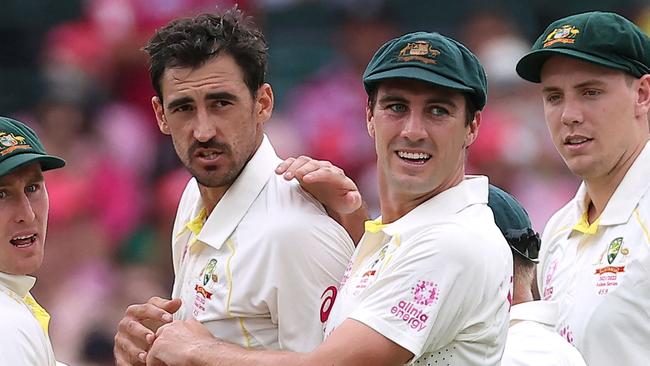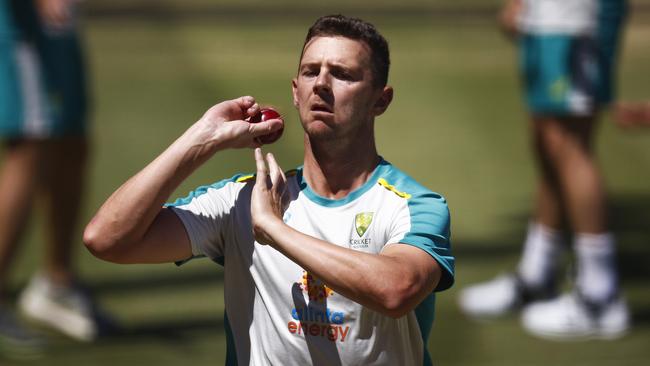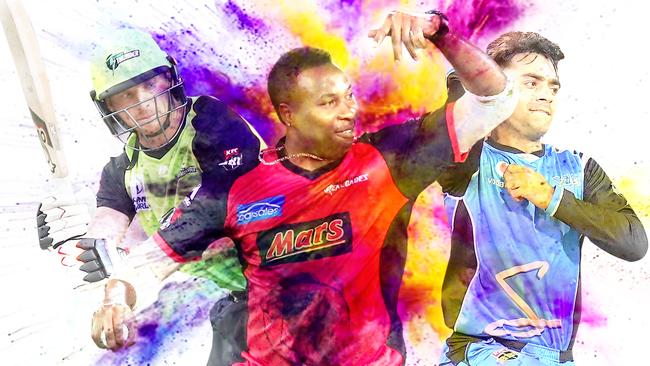Cricket 2022: Tight summer schedule could leave Test pacemen short of red-ball cricket
Australia’s top-line fast bowlers may head into the home summer without a game of red-ball cricket under their belts. Find out why.

Big Bash
Don't miss out on the headlines from Big Bash. Followed categories will be added to My News.
Australia’s fast bowling cartel may go into the home Test summer without a single match of red-ball cricket under their belts … unless rested from the ODI series against England.
Cricket Australia has released its domestic schedule, including an expanded 43-game WNCL women’s competition, and a return to full Sheffield Shield and one-day cup schedules following the ravages of Covid.
There will be five rounds of Shield before the first Test against the West Indies starts on November 30, however, the matches clash with Australia’s Twenty20 World Cup campaign and subsequent three ODIs against England.
Watch Australia’s Tour of Sri Lanka. Every T20, ODI and Test Match Live & On-Demand on Kayo. New to Kayo? Try 14-Days Free Now >
It means selectors have a tricky juggling act to manage how to properly prepare Pat Cummins, Mitchell Starc and Josh Hazlewood for the rigours of a five-Test summer against the Windies and South Africa.
Last summer Hazlewood broke down during the first Test when the bowlers were similarly robbed of a red-ball build-up.

Cricket Australia will put on a four-day match for those in Test calculations against the West Indies in the lead-up to the first Test, but there is no guarantee the multi-format stars, which also include David Warner and Steve Smith, will be able to play.
It appears to be the new norm, with crammed international schedules fast turning traditional red ball preparation into a relic of the past.
“Some seasons are harder than others and this one, because of the quantity of cricket which has been pushed back from Covid, has certainly made it more of a challenge,” CA operations boss Peter Roach said.
“We’re probably seeing that a little bit when we’re away as well, that our preparation for this Test series against Sri Lanka is not what it historically would have been.
“Equally, it’s the same for the Sri Lankan team.
“… We believe that through good management, come the Test summer, our players will be ready to play Test cricket.
“Does that mean they’ll all play a four-day game? It obviously depends on how long we go in the World Cup – we’ve looked at how we can best give opportunities if certain things happen, but with no guarantees it will play out that way.

“That is a challenge, and this year probably more than ever with a home World Cup.”
Australia’s best women’s players will now play two matches against each team in the 50-over WNCL, starting on September 23 with a day-nighter between NSW and Queensland at North Sydney Oval.
The men’s one-day cup also starts on September 23, with six games in nine days, all broadcast on Fox Cricket.
The Sheffield Shield kicks-off on October 3, with a clash between WA and NSW a the WACA in Perth.
Under-age championships for male and female under-19s, under-16s female and under-17s male will also return this summer.
Inside the plan to get Aussie Test stars back to BBL
-Ben Horne
Faf du Plessis, Quinton de Kock, Eoin Morgan and Andre Russell are among the international superstars the Big Bash is targeting for its inaugural player draft.
Under enormous pressure by new pop-up leagues in South Africa and the UAE as well as the expectations of its own broadcasters to rejuvenate the product, Cricket Australia has revealed a pragmatic strategy where big overseas names could earn $340,000 in the draft for as little as eight games work.
The draft is set to take place in late August and likely be broadcast as a live event by Fox Sports, who want to help CA turn it into attractive TV entertainment – and may look to have it run off the back of a major NRL or AFL match.

Aware it can’t compete head-on with the $700,000 salaries being proposed by the UAE and $500,000 being mooted in South Africa, Cricket Australia is taking the realistic approach of offering overseas stars the chance to have their cake and eat it too.
The UAE and South African competitions may not start until mid-January, so Cricket Australia is inviting South African pantomime villains du Plessis and de Kock, England captain Morgan, West Indian stars Russell, Sunil Narine and Kieron Pollard and BBL favourite Rashid Khan to come to the BBL from December and leave with their blessing and $340,000 in the back pocket at whatever point they nominate, should they have another more lucrative pay day to attend to elsewhere.
The other intended benefit of the draft system is to force clubs, who in the past have preferred to invest in players in their own state programs instead of head-hunting international stars, to now go after the big fish and be held publicly accountable for their decision-making.
If a team chooses to turn down a chance to get a T20 colossus and TV ratings magnet like du Plessis on their books, they must explain why.
Cricket Australia might not be able to produce the cash that their private investor rivals in the UAE and South Africa can, but the early bird gets the worm, and the Big Bash has now put its cards on the table.
Whereas previous attempts to set up leagues in South Africa and the UAE have failed, the Big Bash at least has a reputation as reliable employers and with a draft proposed for late August, they might be able to benefit from locking in stars before their competitors have got their ducks in a row.
BELOW: HOW THE INAUGURAL BIG BASH LEAGUE DRAFT WILL WORK
“We think giving clubs and players some certainty around their summer is important, particularly in the context of a global market where there is some uncertainty,” said BBL Boss, Alistair Dobson.
The power is with the overseas star, because if a Rashid Khan plays his hand correctly he could earn $1 million dollars for six weeks’ work in December-January, split across two T20 competitions.
While it might mean an exodus of overseas stars come the halfway point of the competition, Cricket Australia is hoping its home grown Test stars can then step into the void, with the growing possibility there will be no international cricket in January after the Sydney New Year’s Test.
Clubs will be told to keep at least one roster spot open should the chance arrive to sign an Australian Test star at the last minute.

Overseas players have about two months to decide whether they want to nominate for the draft, where they must categorise themselves as either Platinum ($340,000), Gold ($260,000), Silver ($175,000) or Bronze ($100,000).
These salaries are locked in no matter how many matches an international player makes themselves available for – but they must nominate the length of their availability up front at the draft.
Clubs will be forced to make at least one platinum or gold purchase, which will help raise the standard and the star power of the league for broadcasters and BBL heavies who need to make this season work ahead of a new TV rights deal which is looming large.
“The clubs are educated. They’ll be doing their homework on not only big name players but also on your lesser-known players,” said BBL talent guru, Trent Woodhill.
More Coverage
Originally published as Cricket 2022: Tight summer schedule could leave Test pacemen short of red-ball cricket




